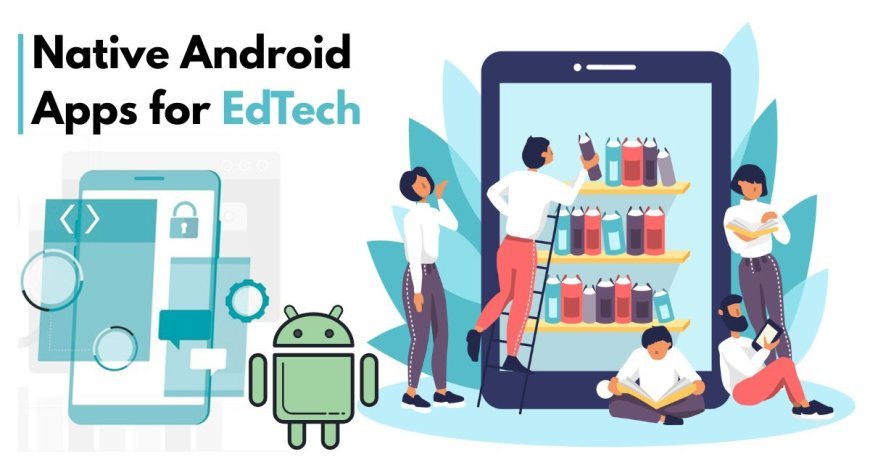Why EdTech Startups Need Native Android Apps

The education technology (EdTech) sector has grown significantly in recent years. According to HolonIQ, global EdTech investment reached $10.6 billion in 2023, highlighting strong investor confidence. Meanwhile, Android maintained its dominance in the global mobile OS market, with a 70.5% market share in early 2025, based on StatCounter data.
For startups operating in this space, selecting the right platform and technology stack for app development is crucial. An Android Application Development Company plays a key role in helping EdTech ventures build scalable, accessible, and performant applications. Native Android apps, in particular, offer unique advantages in performance, usability, and integration. This article explains why native Android apps are critical for EdTech startups, supported by data, technical reasoning, and real-world examples.
Understanding Native Android Apps
Native Android apps are built specifically for the Android operating system using programming languages like Kotlin or Java. They are developed using Android Studio and integrate seamlessly with Android device features. This is in contrast to hybrid or cross-platform apps, which use shared codebases across multiple platforms.
Android's Market Penetration in Emerging Markets
EdTech solutions often target students in developing regions where Android is the primary mobile platform.
Reasons Android dominates in these markets:
-
Availability of affordable Android devices
-
High levels of mobile internet usage
-
Government digital learning initiatives favoring Android tablets or phones
Example:
BYJU'S, one of India's leading EdTech startups, reported that 80% of its mobile users accessed the platform via Android devices.
Performance and Responsiveness
Native apps deliver better performance than hybrid or cross-platform alternatives.
Technical advantages include:
-
Direct access to device hardware such as GPU and CPU
-
Better memory management and resource allocation
-
Faster screen transitions and smoother animations
Real-World Case:
Khan Academy initially used hybrid technology but shifted to native development for Android. They reported improved loading times and better video playback experiences.
Offline Accessibility for Low-Bandwidth Areas
Internet connectivity remains a challenge in many rural and semi-urban locations.
Native Android apps allow:
-
Caching of lessons, videos, and PDFs
-
Local storage of progress data
-
Resume capability for partially downloaded content
Why it matters:
In regions where students rely on limited data plans or unstable connections, offline functionality enhances learning continuity.
Enhanced Integration with Device Features
Native apps offer advanced integration with hardware and OS-level services.
Useful integrations for EdTech apps include:
-
Camera: for submitting assignments or ID verification
-
Microphone: for voice notes or oral assessments
-
GPS: to monitor attendance for location-based learning
-
Push notifications: for timely alerts and reminders
Cross-platform apps often face limitations or require complex workarounds to access these features.
Security and Data Privacy
Student data protection is essential in educational environments. Native Android apps provide more robust security implementations.
Security benefits include:
-
Better control over data encryption and local storage
-
Integration with Android's biometric authentication APIs
-
Use of Google Play’s SafetyNet for app integrity checks
Compliance Considerations:
EdTech platforms must adhere to privacy regulations like GDPR and COPPA. Native frameworks simplify implementing these requirements with tighter API controls.
Scalability and Maintainability
Startups often begin with a small user base that grows rapidly. Native Android architecture supports modularity and clean code practices.
Benefits include:
-
Easier onboarding of new developers
-
Reduced technical debt over time
-
Use of Jetpack libraries to simplify routine tasks
Example:
Toppr, an Indian EdTech startup, scaled its native Android app to support over 2 million users without significant performance issues.
Better Analytics and Monitoring
Native apps integrate deeply with Google’s ecosystem.
Useful tools:
-
Firebase Analytics for real-time usage metrics
-
Crashlytics for error tracking
-
Remote Config to roll out UI changes without updates
This level of integration is harder to achieve consistently with non-native frameworks.
Superior User Experience
User experience directly impacts learning outcomes and retention.
UI/UX benefits of native Android development:
-
Material Design compliance for consistent interfaces
-
Faster app launch and smooth transitions
-
Better responsiveness on a wide range of devices
Fact:
Google’s Material Design guidelines are best implemented natively, ensuring a familiar and intuitive experience for Android users.
Cost Implications
While native development might seem more expensive initially, long-term savings are significant.
Reasons include:
-
Fewer bugs and reduced testing time
-
Less need for third-party plugins
-
Lower crash rates leading to better app ratings
Supporting Stat:
Apps with fewer crashes see 3x more engagement, according to a 2023 Google Developer Report.
Choosing the Right Android Application Development Company
Partnering with a reliable Android Application Development Company ensures that your EdTech product meets performance, security, and design standards.
Things to look for:
-
Experience in the EdTech domain
-
Strong portfolio with scalable apps
-
Knowledge of Android development best practices
A good development partner can future-proof your app and ensure alignment with Android’s evolving ecosystem.
Conclusion
EdTech startups have a unique opportunity to bridge educational gaps using mobile technology. Given Android’s wide user base, especially in developing regions, building native Android apps offers significant advantages.
These include superior performance, offline access, better user experience, robust security, and seamless integration with device capabilities. With the support of an experienced Android Application Development Company, EdTech startups can deliver reliable, impactful solutions to learners around the globe.
By choosing native development early, startups position themselves for scalable success, reduced technical challenges, and higher learner engagement.
Frequently Asked Questions (FAQs)
1. What are the main advantages of building native Android apps for EdTech startups?
Native Android apps offer significant technical benefits that are crucial for EdTech platforms, especially in growth and scaling phases. These include:
-
Superior performance: Native apps access hardware resources directly, ensuring smooth animations, faster load times, and lower latency—vital for real-time quizzes or video lectures.
-
Offline capabilities: Lessons, assignments, and progress data can be stored locally, enabling learning in areas with unreliable internet.
-
Full device integration: Features like cameras, microphones, biometric authentication, and GPS can be used seamlessly, supporting learning verification and personalization.
-
Enhanced security: Native apps allow secure data encryption and easier implementation of compliance standards like GDPR or COPPA.
These factors ensure better user experience, data protection, and scalability—key goals for any EdTech startup.
2. Why is Android more suitable than iOS for EdTech platforms targeting emerging markets?
Android holds over 70% global mobile OS market share, and its presence is even more dominant in emerging economies such as India, Brazil, and Indonesia. Key reasons include:
-
Wide device availability: Android powers both high-end and affordable smartphones, making it accessible to a broader socioeconomic audience.
-
Government and school adoption: Public sector EdTech initiatives often distribute budget Android tablets and phones for digital learning.
-
Developer-friendly ecosystem: Android allows greater customization and lower app publishing costs compared to iOS.
For startups aiming to maximize reach and impact among underserved learners, Android is the logical first choice.
3. How do native Android apps enhance the learning experience for students?
Native apps directly impact student engagement and learning effectiveness through:
-
Improved responsiveness: Faster screen transitions and real-time content updates reduce friction during study sessions.
-
Rich multimedia support: Native integration ensures better video, audio, and animation quality, which are key for interactive lessons.
-
Push notifications: Important updates such as assignment deadlines, test reminders, and live classes can be delivered instantly.
-
Offline support: Learners can continue studying even without an active internet connection—especially critical in rural regions.
Together, these features make the app more reliable, engaging, and learner-centric.
4. Are native Android apps more expensive to develop than cross-platform apps?
While the initial development cost for native Android apps may be slightly higher, they are often more cost-effective long-term. Here's why:
-
Lower maintenance issues: Native apps crash less often and have fewer compatibility bugs.
-
No dependency on third-party plugins: Native tools and SDKs reduce external library costs and instability.
-
Faster updates and better scalability: Native codebases are easier to optimize for performance and newer Android versions.
-
Higher user retention: A smoother, more reliable app experience leads to better reviews, reduced churn, and higher app store rankings.
An experienced Android Application Development Company can also help optimize development processes to reduce costs.
5. What should EdTech startups look for when hiring an Android Application Development Company?
Choosing the right development partner is critical. EdTech startups should evaluate companies based on:
-
Domain expertise: Experience in building learning management systems (LMS), video-based learning, gamified education apps, etc.
-
Technology stack proficiency: Strong command over Kotlin, Android Jetpack libraries, Firebase, and security protocols.
-
Portfolio & case studies: Proven success in delivering scalable Android apps for education or similar user-focused domains.
-
Post-launch support: Ongoing maintenance, analytics integration, and performance monitoring capabilities.
-
Agile methodology: Ability to iterate quickly based on user feedback, ensuring continuous improvement.
These factors ensure that the development company is not just a vendor but a long-term strategic partner.
What's Your Reaction?



















































